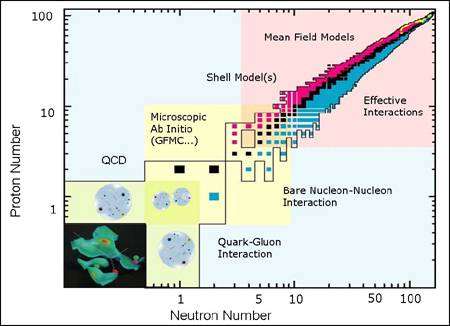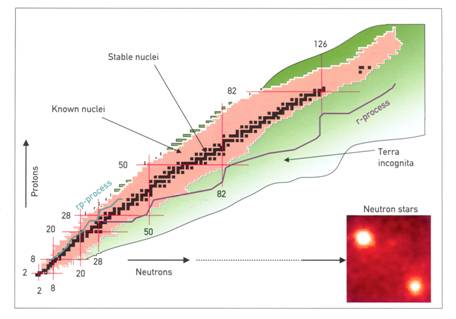Result 2
Low Energy Nuclear Structure and Astrophysics
With its links to both the nano-scale world and to the cosmos, and with its origins in QCD, the study of the femto-region of atomic nuclei is central to modern physical science, with effects spanning over 42 orders of magnitude in distance scale from 10-15 m to 1027 m or more.
Research in nuclear structure aims to understand the nature of atomic nuclei, in particular, their dependence on the number and interactions of their constituents. These are usually taken to be free nucleons -protons and neutrons- although a QCD-based interpretation in terms of quarks and gluons is a long term goal. The ultimate aim of nuclear structure is to develop a simple, coherent, comprehensive theory and understanding of nuclei and of nuclear reactions in all their manifestations in which our present, often ad hoc, models will likely be seen as projections applicable to particular subsets of nuclei near stability. Nuclear astrophysics focuses on the study of the reactions and decay properties of nuclei involved in stellar phenomena, in particular energy generation in stars and the various processes associated with nucleosynthesis. With the advent of advanced facilities for the production and study of exotic nuclei far from stability, both fields are enjoying a resurgence of activity and discovery, with prospects for a future brighter than ever.

For over a century, the study of nuclei and nuclear techniques has also produced many innovative applications, to areas as diverse as medicine, security, industrial manufacturing, and energy. Examples are the development of new concepts of fission and fusion reactors, the search for solutions to the problem of long-lived nuclear waste, the development of myriad diagnostic and therapeutic techniques in medicine and control apparatae for industrial manufacturing. In addition, research in low energy nuclear physics is a prime training ground for those interested in working in applied areas.
Two themes and challenges run through much of the quest to understand nuclear structure: complexity and simplicity. The first is to understand how these complex many-body objects can be constructed from simple ingredients (nucleons, their interactions, quantum numbers, and conservation laws). This is the microscopic approach and has intimate links to techniques and research in nano-scale systems. The second is to understand how these complex objects can display such astonishing simplicity. This approach is more macroscopic, focusing on geometry and descriptions in terms of dynamical symmetries.
Both approaches seek to understand not merely the properties of individual nuclei but the evolution of those properties with N , Z, and A , including sudden changes (similar to phase transitions) in structure with the addition of only a couple of nucleons.
The emerging accessibility of vast numbers of unstable nuclei far from the valley of stability (Fig. 2) is revitalizing the field by giving access to the limits of bound nuclei and to long iso-chains within these boundaries where structural evolution can be mapped. Exotic nuclei present new nuclear physics, such as found in the properties of weakly bound quantal systems, the dependence of nucleonic interactions on the in-medium density, the presence of the continuum of positive energy states, exotic topologies such as halo nuclei, changes in shell structure and the traditional magic numbers, properties of the heavy and super heavy nuclei as well as collective modes unlike anything found near stability. Investigations of the properties of the nuclear equation-of-state (EOS) and the associated phase diagram allow study of static properties of asymmetric matter, the thermodynamics of exotic nuclei, and the density and momentum dependence of the isovector interaction.
In addition to new, next-generation accelerator facilities, significant advances in experimental techniques are key to this research. Advanced facilities for exotic beams will provide stopped nuclides and beams ranging from keV to hundreds of GeV and provide thousands of nuclei far from stability with orders of magnitude greater intensities than at present. Examples of current facilities central to this work include Louvain la Neuve, TRIUMF ISAC-I, MSU-NSCL, HRIBF, SPIRAL1@GANIL, GSI, REX ISOLDE, and RIKEN. Next generation facilities, under construction or proposed, include RIKEN RIBF, TRIUMF ISAC-II, SPIRAL2@GANIL, GSI-FAIR, EURISOL, and RIA. The aim, of course, is not to study all nuclides available but to choose from the expanded "gene pool" to select those that isolate and amplify particular physics issues. New experimental developments involve the concept of inverse kinematics in which the traditional roles of target and projectile are reversed. This approach is necessary with reactions involving unstable exotic nuclei but its many inherent advantages mean that it is now also being used with stable beams. Advances such as the use of large γ-ray tracking arrays, powerful fragment separators, advanced optical and magnetic traps, storage rings, and laser spectroscopy, along with the exploitation of new types of reactions, such as knock out reactions and intermediate energy Coulomb excitation, are revitalizing experimental capabilities. Where, once, beams of 109 particles/sec were standard, experiments can now be done with orders of magnitude lower beam intensity, and, in selected cases, at rates well under 1 particle/sec.
Of course, research at the fringes of stability does not preclude the need for stable beam capability to help answer the new questions raised by those studies. Likewise, complementary experiments with neutron beams (thermal, cold, and ultracold) at both accelerators and reactors will complement research with charged particle reactions.
Theoretical descriptions have also made significant progress. Ab initio calculations of nuclei now extend to A ~12 and no-core and Monte Carlo shell model techniques go much further. For heavier nuclei, density functional theory and the shell model embedded in the continuum promise paths towards a coherent theoretical treatment. Complementary to this, the development of dynamical symmetries and the new critical point descriptions for nuclei in the region of phase transitions are providing new paradigms and benchmarks of structure.
Key areas of nuclear astrophysics are: understanding energy generation in steady burning processes such as the pp chain, CNO cycle, and helium burning, and explosive burning processes, like the hot pp chain, hot CNO cycle, and rp process which ignite by breaking out from steady burning and form nuclei in the Ne to S range or even heavier nuclides; understanding the cosmic origin of radiations currently being observed with a variety of satellite orbiters; understanding the nucleosynthesis of the heavier elements through the rp, p, s, r, and other processes and the stellar sites where many nuclides beyond Fe are produced in cataclysmic stellar explosions such as supernova. Primordial nucleosynthesis just after the Big Bang is another area where a deeper understanding of nuclear processes is much needed.
Energy generation in stars is caused by low-energy charged particle reactions. Their low cross section due to the Coulomb repulsion hinders measurements that are carried out with high backgrounds. Experiments in an underground laboratory succeeded in measuring cross sections of the solar fusion reaction 3He( 3He,2p)4 He at its Gamow-window energies around 20 keV. Another way to overcome the difficulty is to employ a method to "amplify" the small cross sections. Coulomb dissociation uses high-intensity virtual photons during a heavy-ion collision. The ANC (Asymptotic Normalization Coefficient) determines the amplitude of a wave function in its asymptotic region by an appropriate nuclear reaction with a larger cross section. The "Trojan Horse" method employs a three body quasi-free process that simulates a rearrangement reaction. These indirect methods help to access difficult-to-measure reactions.
The recent development of radioactive nuclear beam techniques has opened new possibilities to measure reactions in explosive burning involving short-lived nuclei. Several reactions in the hot CNO cycle and the rp process have already been directly studied. The Coulomb dissociation and ANC methods are also applied to various reactions with unstable nuclei. Further developments will be made by the next generation facilities with radio-active nuclear beams.

Heavy element synthesis is by neutron or proton capture, their inverse processes, and β decays. In majority of cases, basic nuclear properties such as mass, half-life, level density, etc ., are important. Recent developments of experimental and theoretical techniques have advanced our understanding of heavy element synthesis through slow or rapid capture processes. However, most of the nuclei involved in the explosive r- and rp-process are very far from the stability valley, and their study is just beginning. In addition, the neutrino-nucleus interaction may be important in understanding the explosive mechanisms of supernova. To fully understand explosive nucleosynthesis is a major challenge that can be attacked only by the above-mentioned, new radioactive-beam facilities, where the expected pathway of the r-process might be covered. Several new techniques for mass measurements, β decay studies and the like are being developed. Together with the rapid expansion of astronomical observations, which is clarifying details of the heavy element abundance in specific astrophysical objects, and experimental and theoretical studies on stellar explosion mechanisms, the origin of heavy elements is expected to be significantly clarified in the next two decades.